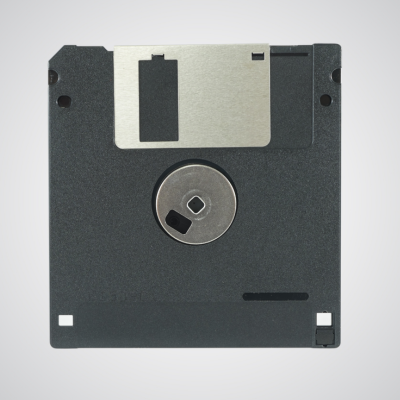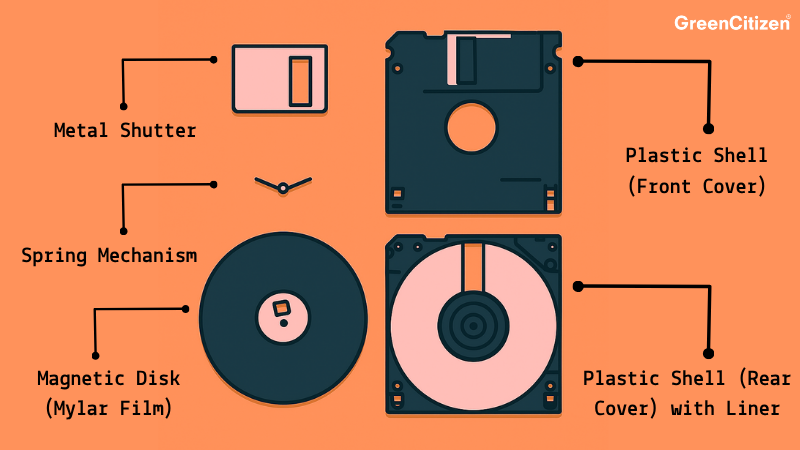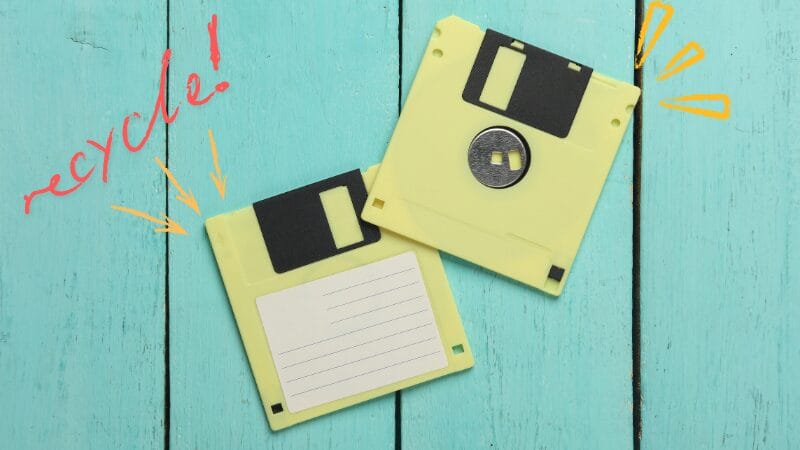Once a symbol of cutting-edge computing, the floppy disk is now a relic of another digital era. Yet millions still exist — tucked away in office archives, research labs, and personal storage boxes — each containing plastics, metals, and sometimes sensitive data.
If you’re wondering how to recycle floppy disks safely, the answer lies in treating them like what they are: regulated e-waste that demands secure and responsible disposal. This guide explains how to handle old floppy disks correctly, protect any stored information, and keep obsolete media out of landfills.
💡 Key Takeaway: How to Recycle Floppy Disks
You can recycle floppy disks through certified e-waste recyclers that safely process their plastic, metal, and magnetic materials. Always erase or destroy stored data before recycling, then use pickup, mail-in, or drop-off services to ensure secure destruction and full material recovery — keeping outdated media out of landfills.

Dispose of Floppy Disks the Secure Way
Old floppies can still store sensitive information. GreenCitizen provides certified floppy disk recycling with full data destruction and recycling certificates — perfect for offices, schools, and home archives.
Can You Recycle Floppy Disks?
Yes — you can recycle floppy disks through certified e-waste recyclers that safely process plastics, magnetic film, and metal components.
They’re made of non-biodegradable plastics, thin Mylar film coated with iron oxide, and small metal parts — all materials that require specialized processing to recover safely. Because they contain magnetic media, floppy disks shouldn’t go in regular recycling bins or trash.
Floppy disks fall under electronic waste (e-waste) regulations rather than hazardous waste. Certified recyclers dismantle or shred the disks to separate plastics, metals, and magnetic film, ensuring these components are refined for reuse instead of entering landfills.
When recycled properly, over 90% of a floppy disk’s material can be recovered.
If the disks once stored sensitive information, it’s best to erase or destroy the data before recycling. This can be done using a strong magnet (degaussing), data-wiping software, or by working with recyclers that provide secure data destruction certificates — a critical step for business or institutional media.
For individuals, mail-in recycling programs and local e-waste collection centers offer safe drop-off options. Businesses or schools with large batches should use a certified recycler that offers pickup or verified data destruction.
♻️ In short: You can recycle floppy disks through certified e-waste recyclers that handle magnetic media — keeping plastics out of landfills and ensuring your data stays protected.
What Is a Floppy Disk Made Of?
A floppy disk is made of a thin magnetic film coated with iron oxide, enclosed in a plastic shell with small metal components for alignment and protection. Together, these materials form a lightweight data storage device that’s simple in design but complex to recycle.

1. Magnetic Storage Medium
- Material: Thin, flexible sheet of polyester film (Mylar) coated with iron oxide or barium ferrite.
- Purpose: This is the actual recording surface where data is stored magnetically.
- Characteristic: The “floppy” part — it’s flexible, unlike the rigid platters of hard drives.
2. Protective Outer Shell
- Material: Hard or semi-rigid plastic casing (usually PVC or ABS).
- Purpose: Protects the magnetic disk inside from dust, fingerprints, and physical damage.
- Sizes: Commonly 8-inch, 5.25-inch (flexible), and 3.5-inch (rigid) formats.
3. Metal and Mechanical Parts
- Hub ring: Small metal center ring helps the drive spindle grip and spin the disk accurately.
- Shutter (on 3.5-inch disks): A spring-loaded metal cover that slides open when inserted into a drive to expose the magnetic surface for reading/writing.
- Index hole / write-protect notch: Small cutouts or holes used by the drive to detect disk position or write protection status.
4. Lubricants and Anti-Static Coatings
- Applied to reduce friction between the disk surface and the read/write head.
- Helps prevent static buildup that could damage data.
♻️ Note: While most plastic and metal from floppy disks can be recycled, the magnetic film and certain coatings can’t be recovered safely. For these materials, GreenCitizen partners with Reworld, a certified Waste-to-Energy (WTE) facility that uses controlled, regulated incineration to ensure secure and compliant disposal.
Reworld’s WTE process completely destroys magnetic media — eliminating any chance of data recovery — while converting waste into usable electricity or steam. Their temperature-controlled incineration and advanced filtration systems meet strict EPA and state environmental standards, providing a safe alternative to landfilling.
Are Floppy Disks Hazardous Waste?
No — floppy disks aren’t considered hazardous waste, but they are classified as electronic waste (e-waste) because of the materials they contain and the way they must be disposed of.
While they don’t contain toxic metals like mercury or lead, they still pose long-term environmental risks if thrown in the trash.
Under the EPA, WEEE Directive, and California DTSC, floppy disks are grouped with electronic storage media such as CDs, DVDs, and magnetic tapes.
They lack the heavy metals or brominated flame retardants found in circuit boards and CRTs, so they aren’t “hazardous” under hazardous-waste laws — but they’re regulated e-waste that must go to certified recyclers rather than paper or plastic streams.
Floppy disks contain PVC or ABS plastic casings and a Mylar film coated with iron oxide.
Thousands of archived disks tossed at once can also create bulk-waste compliance problems for offices and institutions.
Even decades-old disks can hold recoverable data.
Certified e-waste recyclers use degaussing, magnetic shredding, or controlled incineration to destroy stored information before processing the materials — protecting businesses from privacy breaches and regulatory violations.
✅ Floppy disks are not hazardous waste, but they are regulated e-waste. They must be recycled through certified facilities that ensure secure data destruction and environmentally responsible material recovery.
How To Recycle or Destroy Floppy Disks: Step-by-Step Guide
You can recycle floppy disks through certified e-waste programs — but always erase or destroy the data first.
Floppy disks are made from plastics, magnetic film, and metal parts that can be recovered, but they must never be thrown in the trash or blue bins.

Step 1: Sort Your Floppy Disks (Assume They’re Sensitive)
You don’t need a working floppy drive to start — just treat every disk as potential sensitive media and sort them so they can be handled correctly.
Group 1: Business, Government, Or Research Disks
Anything with company names, project labels, client info, finance/HR/legal references, or handwritten notes → treat as confidential. These should go directly to a certified e-waste recycler with secure data destruction (shredding/degaussing).
Group 2: Personal Or Unlabelled Disks
Old home backups, school work, random filenames, or mystery disks → still treat as sensitive by default. They’re cheap to destroy properly, and you avoid surprise data leaks.
Group 3: Clearly Blank Or New-Old-Stock
Sealed blank disks or disks you’re sure were never used can be set aside for upcycling or standard e-waste recycling.
If you truly need to recover files (e.g., legal records, engineering data), you can use an external USB floppy drive or a specialized data transfer service — but this is optional and niche, not the default expectation.
Step 2: Handle Data Securely — At Home vs. Through Certified Recyclers
Even though floppy disks seem outdated, they can still store retrievable data. The safest approach is to assume every disk contains sensitive information and handle it accordingly.
How to Recycle Floppy Disks at Home (Basic Data Protection)
If you’re recycling floppy disks yourself, focus on containment, not erasure. Gather the disks in a sealed bag or box and treat them as confidential materials. Avoid trying to read them on old drives — it’s unnecessary and can expose your system to malware.
For a little extra security, you can crack the plastic shell or snip the magnetic film, but this only prevents casual recovery. True data destruction requires the specialized equipment used by certified e-waste recyclers.
Why You Should Let Certified Recyclers Handle Floppy Disk Data Destruction
Professional e-waste recyclers have industrial tools and chain-of-custody systems designed for magnetic media:
- Degaussing: High-powered magnetic fields permanently erase all stored data.
- Industrial shredding: Shreds disks into fine metal-plastic fragments that make recovery impossible.
- Controlled incineration or melting: Some facilities use temperature-controlled furnaces to neutralize residual magnetic coatings.
- Certificate of data destruction: Confirms compliance with privacy and e-waste laws (HIPAA, GDPR, DTSC, etc.).
✅ Best practice: For any disks from offices, labs, or archives, skip DIY destruction and let a certified e-waste recycler handle both data sanitization and material recovery in one secure process.
Step 3: Where and How to Recycle Floppy Disks
The best way to recycle floppy disks is through certified e-waste recyclers that can safely separate their plastic, metal, and magnetic components.
Unlike paper or household plastics, floppy disks require specialized equipment to recover usable materials without releasing microplastics or contaminants.
Certified recyclers such as GreenCitizen in the San Francisco Bay Area, ERI, and other R2- or e-Stewards–certified facilities use an industrial process that shreds, sorts, and refines floppy disks into reusable raw materials. The plastic casing (PVC/ABS) is ground into pellets, while steel rings and aluminum shutters are extracted magnetically and melted for reuse. The magnetic Mylar film is separated and neutralized before safe disposal.
If you don’t have access to a local recycler, you can use mail-in recycling programs like GreenCitizen’s mail-in service, GreenDisk Technotrash, or TerraCycle. These services accept small quantities of disks and other magnetic media, ensuring full data destruction and compliant recycling.
Some national retailers, including Best Buy and Staples, may accept floppy disks with small electronics during e-waste drop-off events — but always confirm before visiting, as policies vary by location.
⚠️ What Not to Do When Recycling Floppy Disks
- Don’t throw floppy disks in the trash or curbside recycling.
- Don’t burn them — fumes from PVC and magnetic coatings are toxic.
- Don’t donate or resell disks containing old data unless they’ve been securely wiped.

Dispose of Floppy Disks the Secure Way
Old floppies can still store sensitive information. GreenCitizen provides certified floppy disk recycling with full data destruction and recycling certificates — perfect for offices, schools, and home archives.
How to Recycle Floppy Disks with GreenCitizen
Even obsolete media deserves a secure end-of-life. At GreenCitizen, we recycle floppy disks with the same precision and accountability we apply to modern data hardware — protecting both the environment and your information.
Floppy Disk Recycling Cost:
We charge $6 per lb. for recycling, $20 per unit for certified destruction, and an optional $5 certification fee for documented data destruction.
Floppy Disk Recycling for Businesses
Many Bay Area companies, labs, and government offices still store sensitive data on floppy disks — old backups, research logs, or manufacturing records. GreenCitizen offers a recycling service that treats these legacy disks as confidential media.
Our technicians handle every step under our GreenCitizen Total Accountability Management System (GTAMS) — from pickup to certified data destruction. Floppy disks are degaussed, shredded, and material-sorted for recovery.
You receive a Certificate of Recycling and Data Destruction, ready for audit or ESG reporting.
Schedule a secure pickup through our Business Recycling Pickup form — we collect across the Bay Area, Monday to Friday, 10 AM – 6 PM.
Floppy Disk Recycling for Individuals
If you’re cleaning out personal tech or old storage boxes, you can bring your floppy disks to our Burlingame EcoCenter or ship them through our Mail-In Recycling program.
📍 1831 Bayshore Highway, Suite 2, Burlingame, CA 94010
⏰ Open Monday – Friday, 10 AM – 6 PM
At our facility, every disk is securely processed — the magnetic film and metal hub are shredded, the plastics are pelletized for reuse, and all remnants are responsibly managed under California e-waste regulations.
Prefer to ship? Our mail-in option provides nationwide access to the same certified recycling process used for Bay Area businesses.
Why Choose GreenCitizen
- Data-secure: Certified destruction for all magnetic media.
- Environmentally verified: R2 downstream partners, zero landfill policy.
- Accountability built-in: GTAMS tracking and recycling certificates for proof of compliance.
Conclusion: Recycling Floppy Disks the Right Way
Floppy disks may be obsolete, but their environmental and data risks are very real. Made of durable plastics, magnetic coatings, and metal components, they don’t belong in regular recycling or landfill waste. The good news is that almost every part of a floppy disk can be recovered when processed by certified e-waste recyclers.
Whether you’re clearing out old office archives or emptying a home drawer, the safest choice is to recycle floppy disks through certified e-waste programs that guarantee both data destruction and material recovery. Services like GreenCitizen make it simple — offering secure pickups, mail-in recycling, and full documentation
